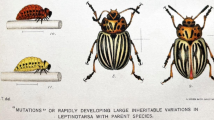Abstract
The effectiveness of immigrants as agents of gene flow was investigated in a laboratory model, using mutant marker strains of the flour beetle, Tribolium castaneum (Herbst).
We show that immigrants had an advantage over residents. The proportion of hybrid offspring (PHO), resulting from immigrant mating with residents, was higher than expected from their frequency in the parental population. This advantage was observed regardless of immigrant sex and immigrant strain. The advantage seems to result from immigrant mating advantage (although not a rare-male phenomenon) and not from better survival of hybrid offspring. However, hybrid offspring seem to be more resistant to sporozoan infection, resulting in higher PHO in sporozoan-infected cultures.
Similar content being viewed by others
References
AverhoffW. W. & RichardsonR. H., 1974. Pheromonal control of mating patterns in Drosophila melanogaster. Behav. Genet. 4: 207–225.
Dobzhansky, T., 1970. Genetics of the evolutionary process. Columbia Univ. Press.
EhrmanL., 1966. Mating success and genotype frequency in Drosophila. Anim. Behav. 14: 332–339.
EhrmanL., 1968. Frequency dependence of mating success in Drosophila pseudo-obscura. Genet. Res. 11: 135–140.
EhrmanL., 1972. Rare male advantage and sexual isolation in Drosophila immigrans. Behav. Genet. 2: 79–84.
EndlerJ. A., 1973. Gene flow and population differentiation. Science 179: 243–250.
GraurD. & WoolD., 1985. Dynamics and genetics of mating behavior in Tribolium castaneum (Coleptera: Tenebrionidae). Behav. Genet. 12: 161–179.
KobylianskyE., LivshitsG. & OrtemskiI., 1989. Ethnic and family factors of some common diseases in early childhood. Human Biology 61: 13–29.
Mayr, E., 1963. Animal species and evolution. Harvard Univ. Press.
OgdenJ. C., 1970(a). Aspects of dispersal in Tribolium flour beetles. Physiol. Zool. 43: 124–131.
OgdenJ. C., 1970(b). Artificial selection for dispersal in flour beetles. Ecology 51: 130–133.
PetitC., 1958. Le determinisme genetique et Psychophysiologique de la competition sexuelle chez Drosophila melanogaster. Bull. Biol. Fr. Belg. 92: 248–329.
PrusT., 1966. Emigrational ability and surface numbers of adult beetles in 12 strains of T. confusum Du Val and T. castaneum Herbst. (Coleoptera, Tenebrionidae). Ekol. Polska 14A: 548–588.
RitteU. & AgurZ., 1977. Variability for dispersal behavior in a wild population of Tribolium castaneum. Tribolium Inf. Bull. 20: 122–131.
RitteU. & LavieB., 1977. The genetic basis of dispersal behavior in Tribolium castaneum. Can. J. Genet. Cytol. 19: 717–722.
SchlagerG., 1960. Sperm precedence in the fertilization of eggs in Tribolium castaneum. Ann. Ent. Soc. Amer. 53: 557–560.
SinnockP., 1970. Frequency dependence and mating behavior in Tribolium castaneum. Amer. Natur. 104: 469–476.
SlatkinM., 1977. Gene flow and genetic drift in a species subject to frequent local extinctions. Theor. Pop. Biol. 12: 253263.
SlatkinM., 1981. Estimating levels of gene flow in natural populations. Genetics 99: 323–335.
SlatkinM., 1985a. Rare alleles as indicators of gene flow. Evolution 39: 53–65.
SlatkinM., 1985b. Gene flow in natural populations. Ann. Rev. Ecol. Syst. 16: 393–430.
SlatkinM. & BartonN. H., 1989. A comparison of three indirect methods for estimating average levels of gene flow. Evolution 43: 1349–1368.
SokalR. R., KenceA. & McCauleyD. E., 1974. The survival of mutants at very low frequencies in Tribolium populations. Genetics 77: 805–818.
Sokal, R. R. & Rohlf, F. J., 1981, Biometry, 2nd Ed. Freeman.
Sokoloff, A., 1966. Genetics of Tribolium and related species. Academic press.
Sokoloff, A., 1972. The Biology of Tribolium vol. I. Oxford.
Sokoloff, A., 1974. The Biology of Tribolium. Vol. II. Oxford.
Sokoloff, A., 1977. The Biology of Tribolium vol. III. Oxford.
SpiessE. B., 1982. Do female flies choose their mates? Amer. Natur. 119: 675–693.
SpiessE. B. & SpiessL. D., 1967. Mating propensity, chromosomal polymorphism and dependent conditions in Drosophila persimilis. Evolution 21: 672–678.
WoolD., 1967. Some observations on mating frequencies in Tribolium castaneum strains. Tribolium Inform. Bull. 10: 182–186.
WoolD., 1970. Deviation of zygotic frequencies from expectation in eggs of Tribolium castaneum. Genetics 66: 155–132.
WoolD., 1982. Critical examination of postulated cladistic relationships among flour beetles (genus Tribolium, Tenebrionidae, Coleoptera). Biochem. Genet. 20: 333–349.
WoolD., 1987. Differentiation of island populations: a laboratory model. Amer. Natur. 129: 188–202.
WoolD. & BergersonO., 1979. Sperm precedence in repeated mating of adults of Tribolium castaneum (Coleoptera, Tenebrionidae). Ent. exp. & Appl. 26: 157–160.
WoolD., BrowerJ. H. & Kamin-BelskyN., 1988. The genetic impact of immigrant males on resident populations of the almond moth, Ephestia cautella (Walker) (Lep. Phyticidae). J. Appl. Ent. 106: 339–344.
WrightS., 1943. Isolation by distance. Genetics 28: 114–138.
ZieglerJ. R., 1976. Evolution of the migration response: emigration by Tribolium and the influence of age. Evolution 30: 579–592.
ZieglerJ. R., 1977. Dispersal and reproduction in Tribolium, the influence of food level. J. Insect Physiol. 23: 955–960.
ZieglerJ. R., 1978. Dispersal and reproduction in Tribolium: the influence of initial density. Environ. Entomol. 7: 148–156.
Zyromska-RudskaH., 1966. Abundance and emigrations of Tribolium in a laboratory model. Ekol. Polska 14A: 491–518.
Author information
Authors and Affiliations
Rights and permissions
About this article
Cite this article
Kaufman, B., Wool, D. Gene flow by immigrants into isolated recipient populations: a laboratory model using flour beetles. Genetica 85, 163–171 (1992). https://doi.org/10.1007/BF00120323
Received:
Accepted:
Issue Date:
DOI: https://doi.org/10.1007/BF00120323




